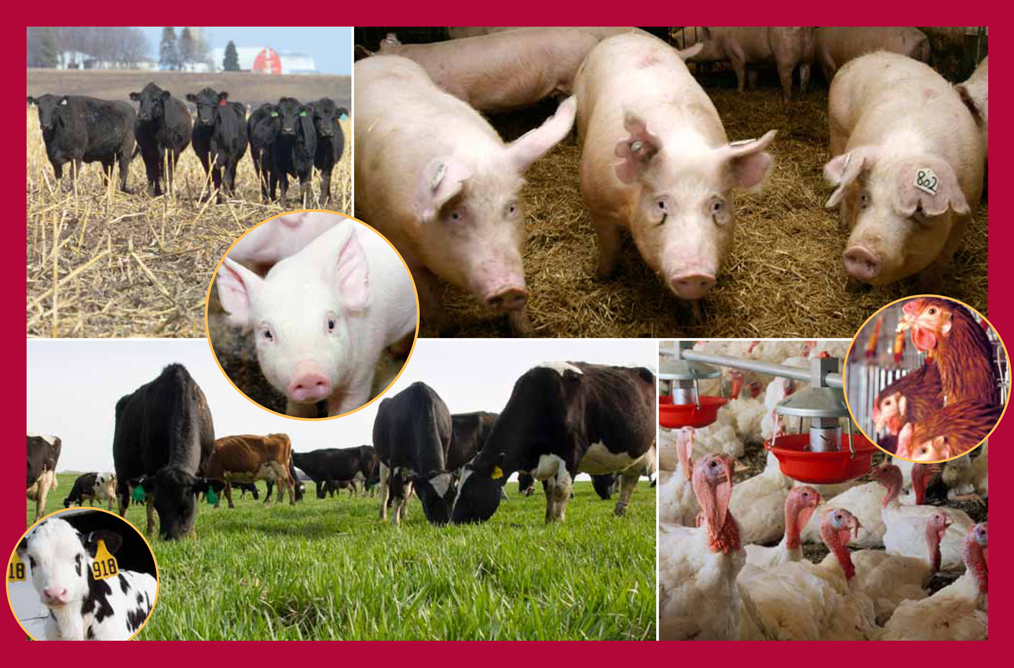The livestock sub‐sector today contributes approximately 13.6 percent of the agricultural GDP and 2.8 percent of the total GDP. This sub‐sector is responsible for the production of poultry meat, eggs, beef, pork, mutton and milk.
Livestock production systems are of various forms which include extensive cattle ranching in the savannahs to promote production of beef. There are also small‐size family farms to promote the production of milk, poultry, small ruminants and pigs.
The poultry industry remains one of the single most important industries in the livestock sub‐ sector in terms of employment, contribution to GDP and production. The poultry industry is dualistic in both its spatial location and structure of production. Large‐scale broiler processors are typically organized on relatively extensive areas that are highly mechanized.
There are an estimated 100 independent commercial broiler farms, varying in sizes from 95 m2 – 1,600 m2. with the large farms accounting for 4,700 m2. A number of processors contract farmers to supply live birds and these ‘contract grower’ farms account for about 38,100 m2 of farm space. In addition, it is estimated that there are some 3,000 small ‘back yard’ farmers with average sizes of 25 m2 .
As for the production of pigs, there are approximately 2500 pig farmers, located mainly in Regions Two, Three, Four, Five and Six. The number of pigs reared in Guyana is approximately 200,000 head; Production is generally a ‘back yard’ type system, pursued mainly by small farmers as part of an integrated farming system. A few farmers practice large scale commercial swine production with over 100 head of pigs. A wide range of local products and by‐ products are used for feeding pigs, these include commercial feeds, rice bran, copra meal, wheat middling, molasses, fish meal, shrimp meal, kitchen waste and swill.
With regard to the small ruminant sector, there are approximately 130,000 head of sheep and 79,000 head of goats. Guyana is one of the countries with the greatest number of sheep within the CARICOM region; however, it is perhaps the country with the lowest production parameters. The carcass dressing weight and other production parameters lag behind those of its Caribbean counterparts.
The local sheep stock is predominantly of the Barbados Blackbelly breed type, and the goats Creole. There is an increased demand for breeding animals; consequently, farmers have been importing other exotic breeds of sheep such as the Katahadin and the Dorper, and there is also a programme for the introduction of the Texel. The use of the Boer breed has seen tremendous increases in the goat parameters
Furthermore, Guyana is believed to have between 220,000 – 250,000 head of beef and dairy cattle. They are spread mainly in Regions Two, Three, Four, Five, Six, Nine and Ten. The principal dairy producing Regions are Two, Three, Four, Five and Six while the main beef producing regions are Regions Three, Five, Six, Nine and Ten. A 2006 census revealed that the cattle populations of Regions Five and Six were 69,478 and 41, 148 heads, respectively.
In an era where pathogens from animals are entering the oceanic as well as human internal ecosystem, a clear picture has emerged regarding emerging diseases. Man is becoming increasingly concerned about accessing safe, wholesome and affordable food, particularly food emanating from livestock. In an effort to develop the architecture that will support our drive to satisfy this need, several entities in livestock were unified under one new arms-length or semi-autonomous agency, the Guyana Livestock Development Authority.
The thrust of the agency is to “promote greater efficiency in the livestock product industry and to provide enhanced services in livestock husbandry, livestock health and research so as to make provision for effective administration and regulation of trade, commerce and export of livestock or livestock products and for matters related and incidental.”
As one of the newest agencies under the Ministry of Agriculture, it delivers public services related to animal production, animal health, animal genetics, marketing, training and extension services as well as regulatory services.
Several programmes are planned and implemented under GLDA’s mandate. One involves protecting the gains of animal production and genetics through the provision of timely veterinary interventions and minimizing the threat of disease from internal and external sources.
Veterinary drugs and the importation of animals are also regulated under this programme. Another programme involves infusing local animal stock with new genetics to enable our farmers to benefit from higher productivity. Techniques of artificial insemination and embryo transfer form part of our regular strategies. Superior genetics is supported by another programme designed to catapult our farmers into higher levels of animal husbandry through better nutrition, housing and access to authentic and validated information.
The country’s livestock population is relatively disease-free except for endo- and ecto-parasitic burdens and their associated diseases. Tuberculosis in cattle has been identified in some enclaves.
Poultry producers have been experiencing undiagnosed conditions of respiratory ailments and nervous (tremor) syndromes. Pigs and small ruminants continue to be affected by endo-parasitic burdens that have not been evaluated.






